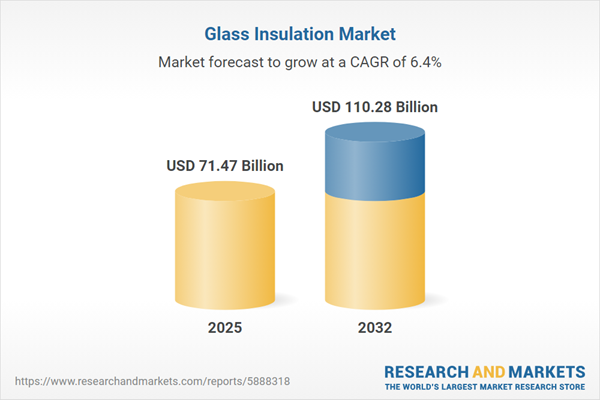Speak directly to the analyst to clarify any post sales queries you may have.
The glass insulation market is rapidly advancing as senior decision-makers emphasize smarter energy management and regulatory alignment across infrastructure portfolios. With evolving project requirements and rising sustainability benchmarks, organizations are leveraging glass insulation for enhanced building performance and streamlined compliance.
Market Snapshot: Glass Insulation Market Size and Growth Outlook
The global glass insulation market is valued at USD 67.21 billion in 2024 and is set to reach USD 71.47 billion by 2025. Backed by a compound annual growth rate (CAGR) of 6.38%, industry projections indicate the sector will reach USD 110.28 billion by 2032. Market momentum is fueled by regulatory updates, construction innovations, and a growing imperative to upgrade energy efficiency in both new developments and retrofit projects. Organizations are focusing on technical advancement, leading to broader adoption in regions prioritizing emission reductions and environmental compliance.
Scope & Segmentation in the Glass Insulation Market
- Product Types: Cellular glass, fiberglass, foam glass, and mineral wool are utilized for their thermal and fire safety characteristics, ensuring alignment with stringent construction and engineering requirements.
- Applications: Roofing, flooring, interior and exterior wall assemblies, and HVAC integration deliver comprehensive energy efficiency, enabling construction teams to optimize both legacy and new infrastructure.
- End Use Sectors: Commercial, industrial, and residential markets—including sectors such as healthcare, education, offices, and retail—adopt glass insulation to address compliance obligations and fulfill operational priorities.
- Installation Types: Compatibility with both new construction and retrofit initiatives allows phased or full-system upgrades, supporting ongoing productivity while meeting project deadlines.
- Forms: Availability as blankets, rigid boards, semi-rigid boards, and loose-fill formats provides adaptable solutions to meet diverse project specifications and challenges.
- Distribution Channels: Direct sales, wholesale, retail, and digital procurement platforms increase accessibility to materials and technical expertise tailored for specialized project needs.
- Regions Assessed: Key geographies include the Americas, Europe, Middle East, Africa, and Asia-Pacific, with special emphasis on regional variations in regulations, technology adoption, and infrastructure investment, notably in China and India.
- Innovative Technologies: Adoption of nanotechnology, improved high-performance binders, and digital modeling tools is enhancing insulation performance and supporting compliance with evolving building codes.
- Key Companies Profiled: Leading organizations include Owens Corning; Compagnie de Saint-Gobain; Knauf Insulation GmbH; Johns Manville Corporation; Chongqing Kanglong New Materials Technology Co., Ltd.; Shandong Huajing Glass Wool Insulation Materials Co., Ltd.; Şişecam Cam Elyaf San. ve Tic. A.Ş.; PPG Industries, Inc.; AGC Inc.; and Nippon Electric Glass Co., Ltd.
Key Strategic Takeaways for Senior Decision-Makers
- Advances in glass fiber technologies are delivering lighter, sustainable solutions that address shifting project criteria and compliance frameworks.
- Solutions designed to lower carbon emissions and support better indoor air standards are increasingly favored in both new and upgrade applications.
- Increased use of building information modeling (BIM) and digitalization is reducing operational inefficiencies and supporting accurate project execution.
- Supply chain resilience now depends on circular economy concepts, with emphasis on recycled and environmentally responsible materials sourcing.
- Rising utilization of digital procurement platforms provides immediate access to technical data and advanced materials for challenging builds.
- Production flexibility is prioritized by manufacturers to meet changing compliance and customer expectations across various regions.
Tariff Impact: Navigating Cost and Supply Chain Shifts
Recent U.S. tariff adjustments are prompting organizations to reevaluate sourcing and inventory strategies. Building stronger relationships with domestic and regional suppliers is helping ensure resilient supply chains and timely project completion, particularly in urban settings with tight construction schedules.
Methodology & Data Sources
This analysis combines insights from manufacturing, engineering, and construction experts. Primary research is integrated with secondary data, including regulatory reviews, patent mapping, and technical literature, providing reliable and current intelligence for evaluating the glass insulation sector.
Why This Report Matters: Strategic Value for the Glass Insulation Market
- Supports benchmarking sector developments and assessing the integration of advanced technologies to inform planning and risk control.
- Equips leadership to adapt procurement strategies and strengthen supply chain agility amid regulatory evolution and market complexity.
- Enables commercial teams to refine growth strategies and proactively align with region-specific standards and shifting buyer expectations.
Conclusion
This market intelligence equips senior leadership to align operations with industry trends, achieve sustainability mandates, and refine commercial positioning as standards and market demands shift.
Additional Product Information:
- Purchase of this report includes 1 year online access with quarterly updates.
- This report can be updated on request. Please contact our Customer Experience team using the Ask a Question widget on our website.
Table of Contents
3. Executive Summary
4. Market Overview
7. Cumulative Impact of Artificial Intelligence 2025
Companies Mentioned
The companies profiled in this Glass Insulation market report include:- Owens Corning
- Compagnie de Saint-Gobain
- Knauf Insulation GmbH
- Johns Manville Corporation
- Chongqing Kanglong New Materials Technology Co., Ltd.
- Shandong Huajing Glass Wool Insulation Materials Co., Ltd.
- Şişecam Cam Elyaf San. ve Tic. A.Ş.
- PPG Industries, Inc.
- AGC Inc.
- Nippon Electric Glass Co., Ltd.
Table Information
| Report Attribute | Details |
|---|---|
| No. of Pages | 198 |
| Published | October 2025 |
| Forecast Period | 2025 - 2032 |
| Estimated Market Value ( USD | $ 71.47 Billion |
| Forecasted Market Value ( USD | $ 110.28 Billion |
| Compound Annual Growth Rate | 6.3% |
| Regions Covered | Global |
| No. of Companies Mentioned | 11 |









